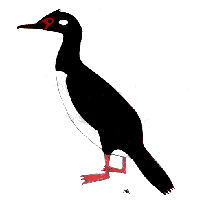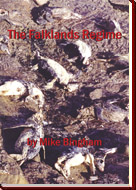 |
 |
| |
|
|
Rock Cormorant Local Name: Black Shag Breeding Range: Falkland Islands,
Chile and Argentina Rock Cormorants breed all around the Falklands, forming small colonies on the ledges of cliffs, jetties and even ship-wrecks. Nests are built from vegetation and seaweed during October, with 2 to 5 eggs being laid in November. Chicks remain in the nest until they fledge during January and February. Adults forage close to shore, particularly favouring kelp beds where they dive to depths of less than 15 metres in search of small fish, crustaceans and cephalopods. Rock Cormorants remain around the Falklands throughout the year. Sexes are similar in appearance. Rock Cormorants are often seen close to shore flying low over the water, and are readily distinguished from the similar King Cormorant by the darker throat and red face patches of the former. |
|
|
||||||||||||||||||||||||||||




